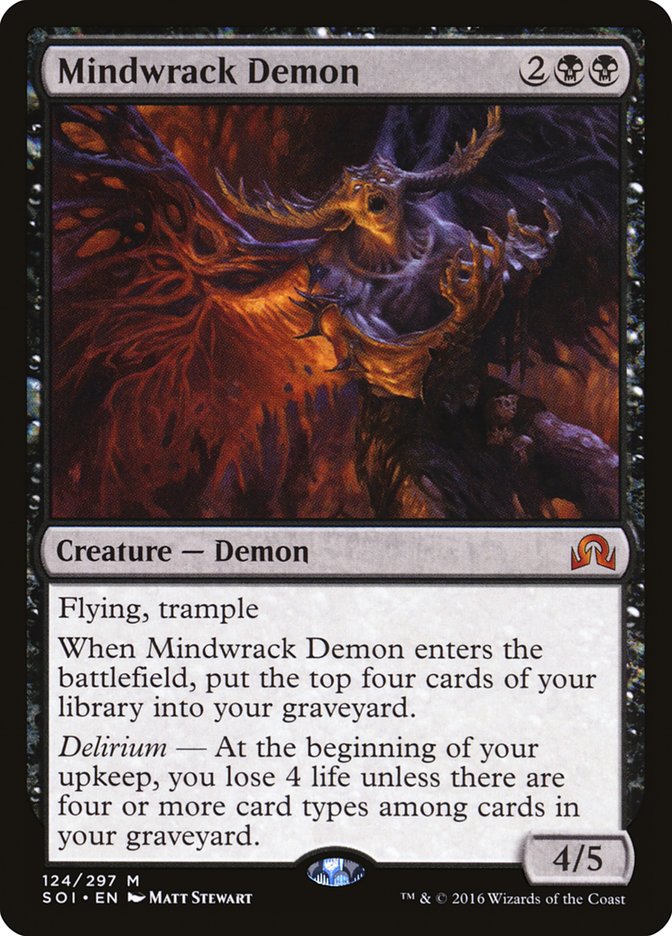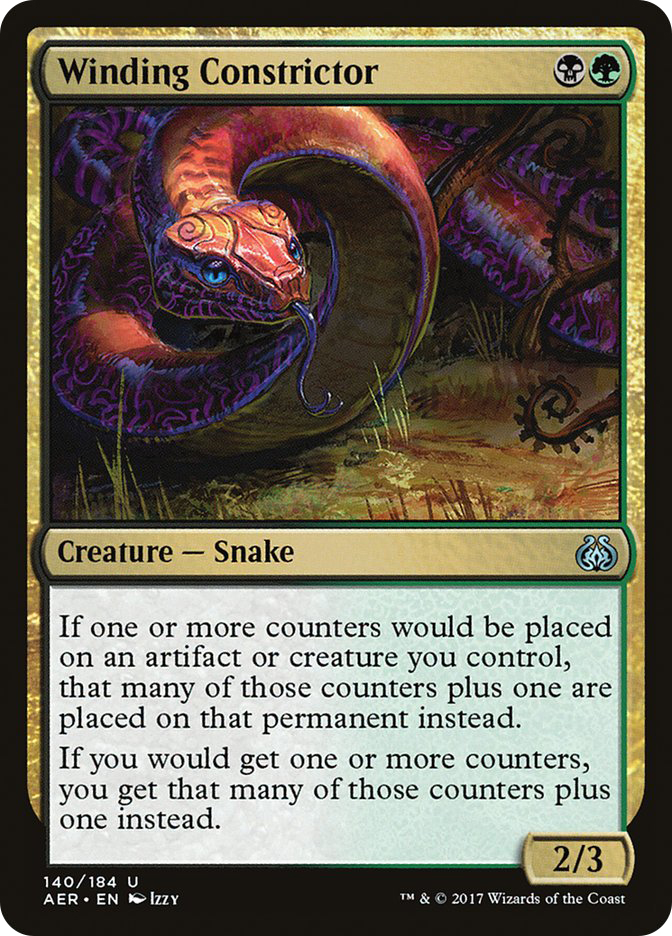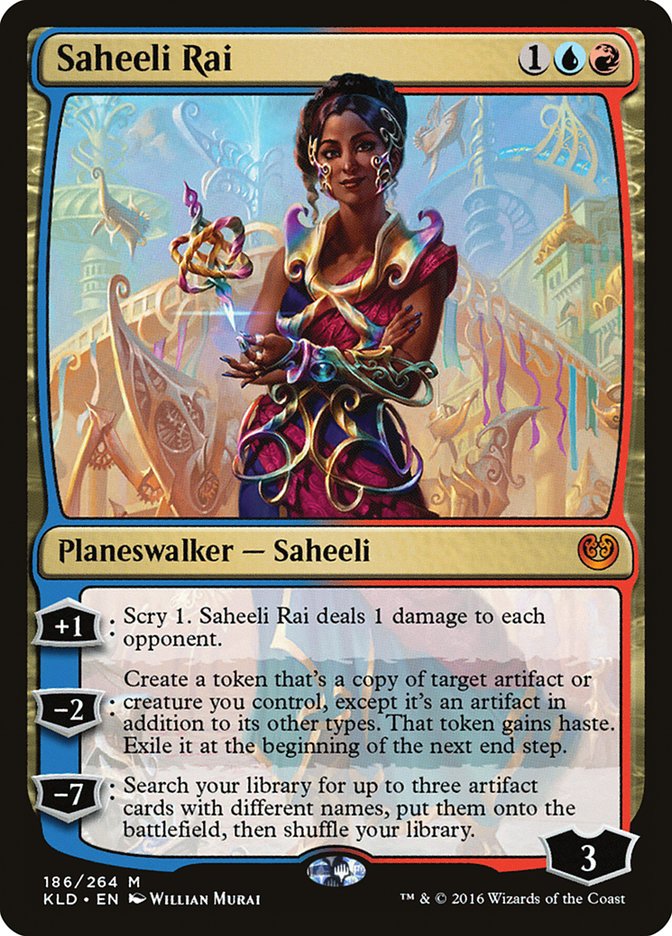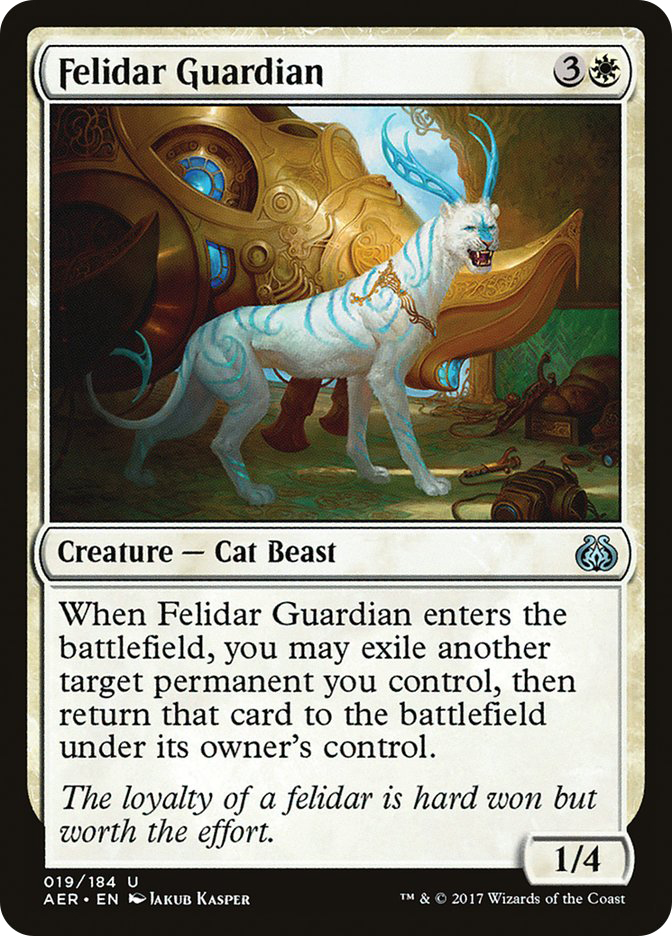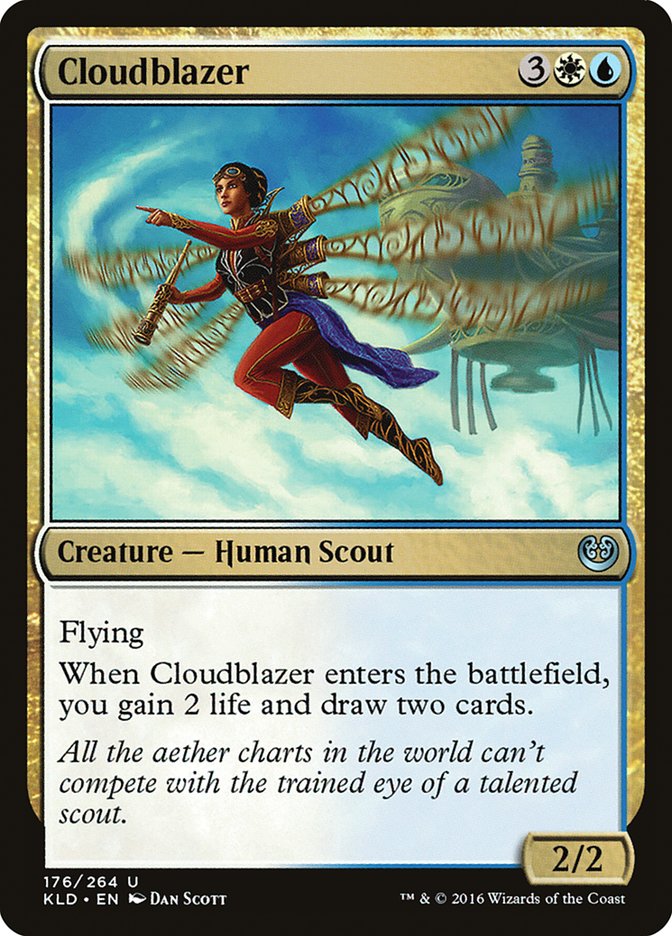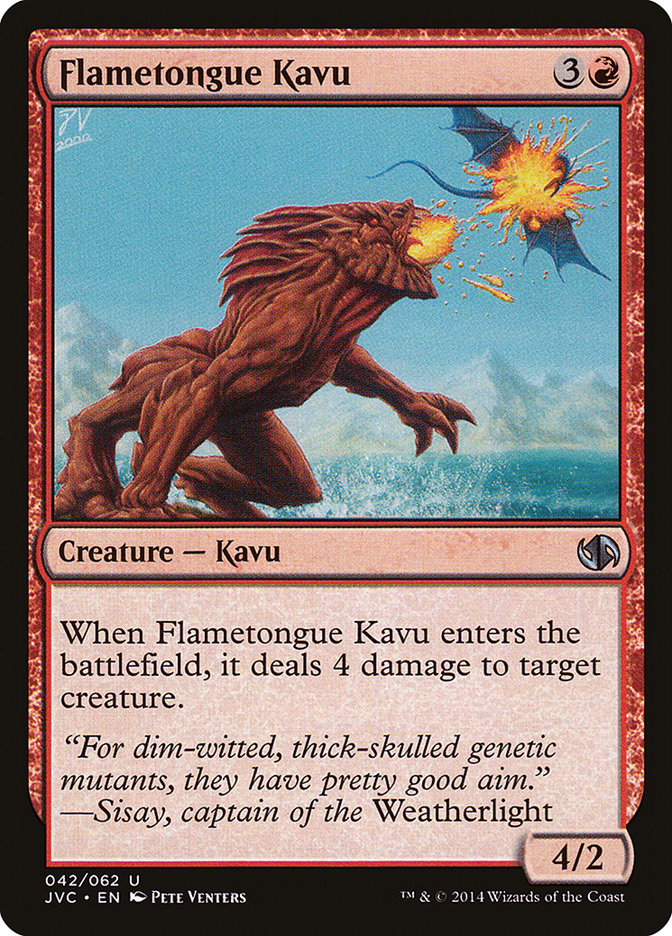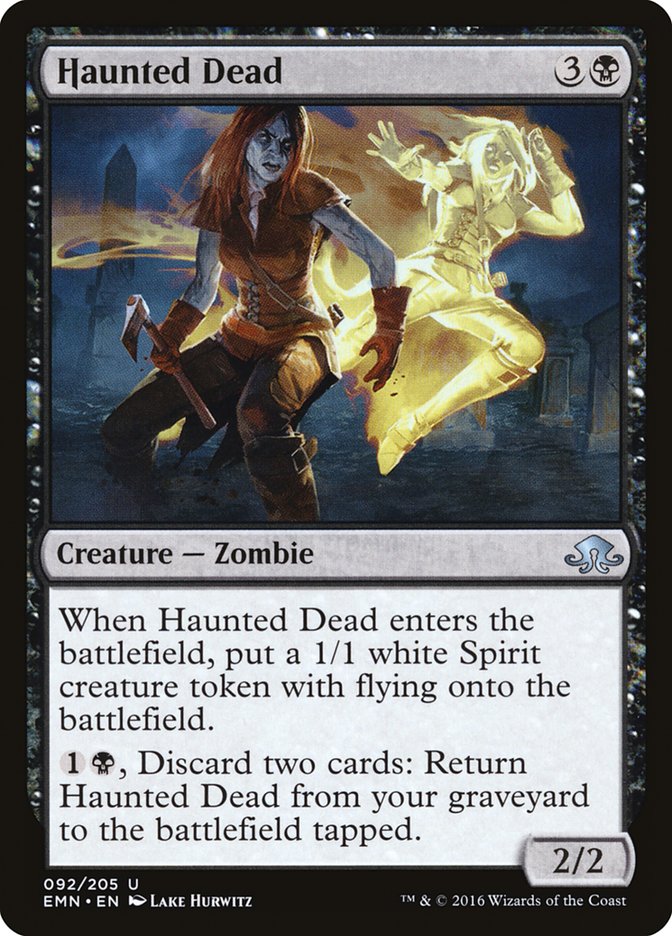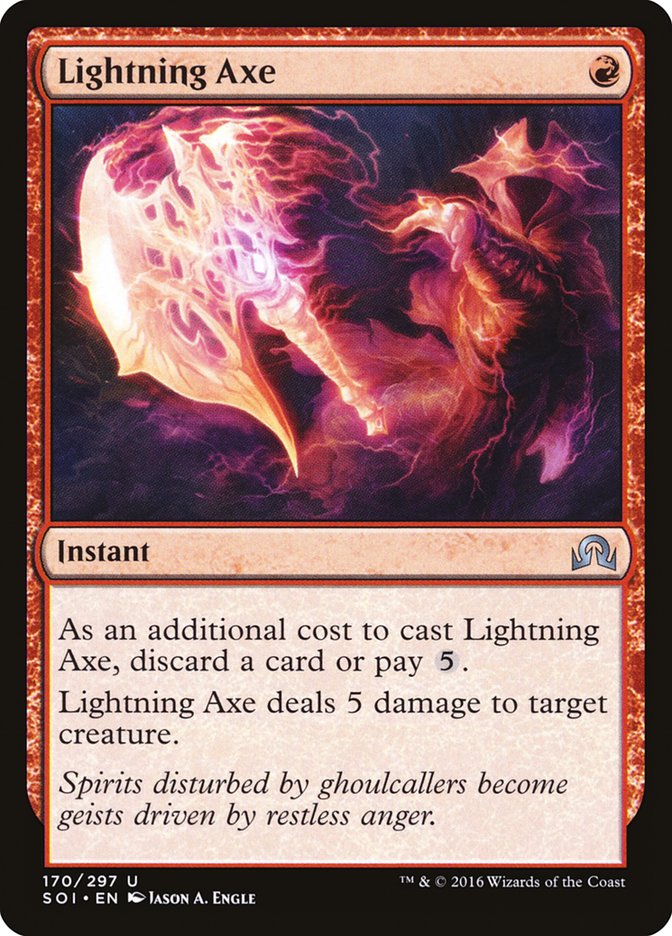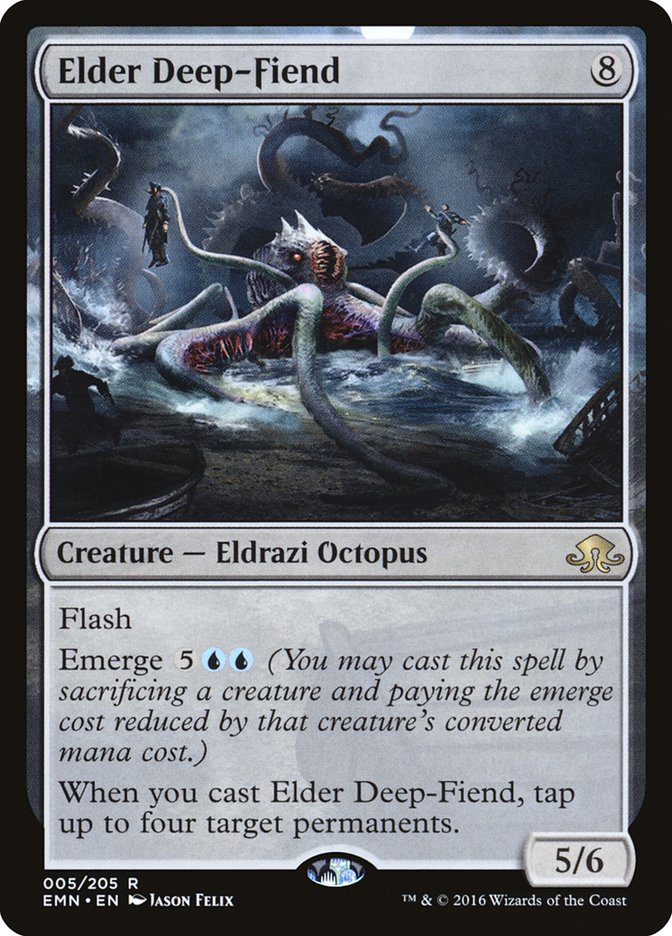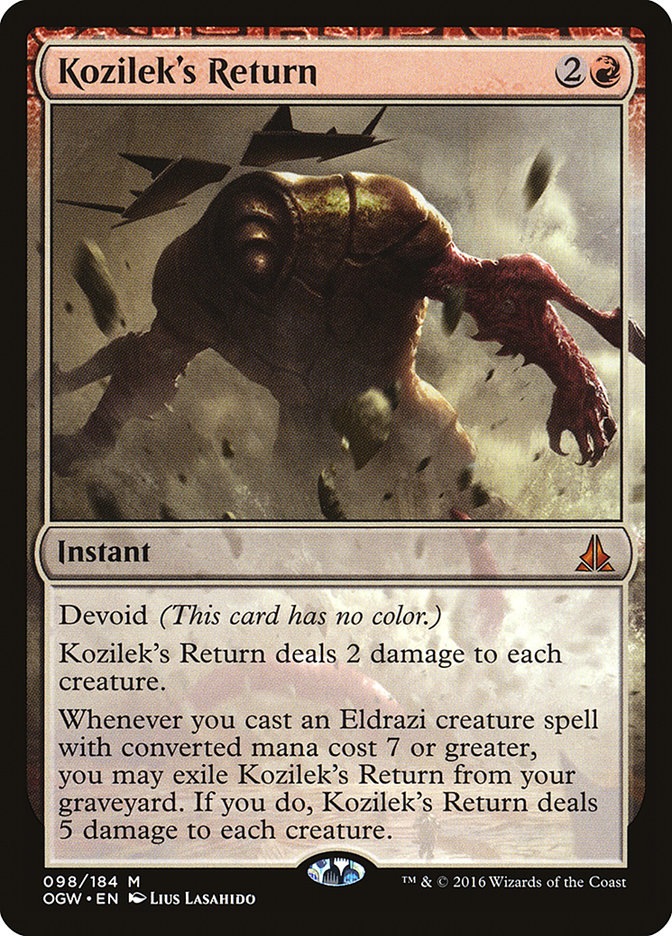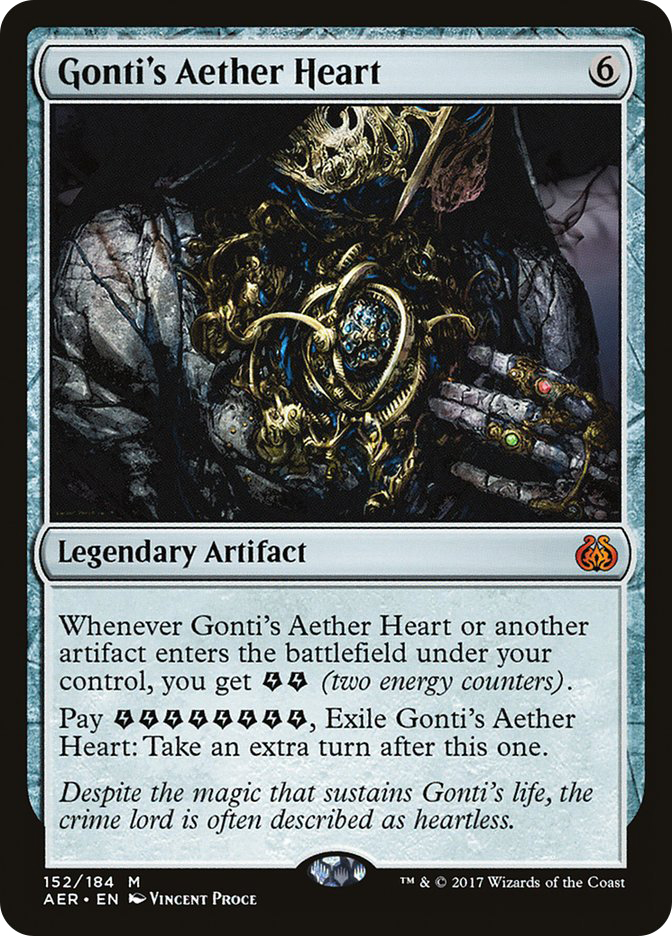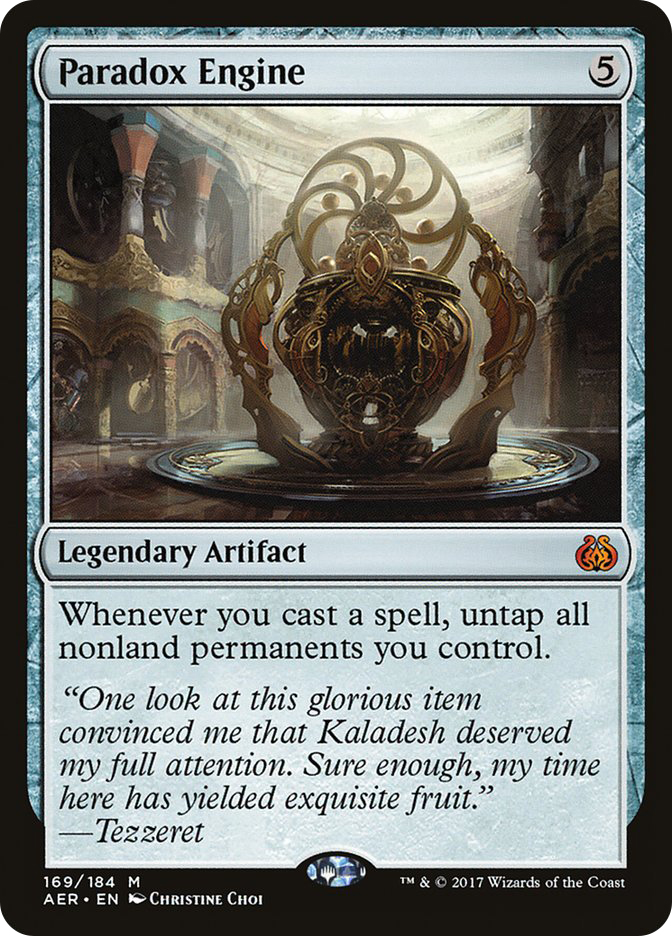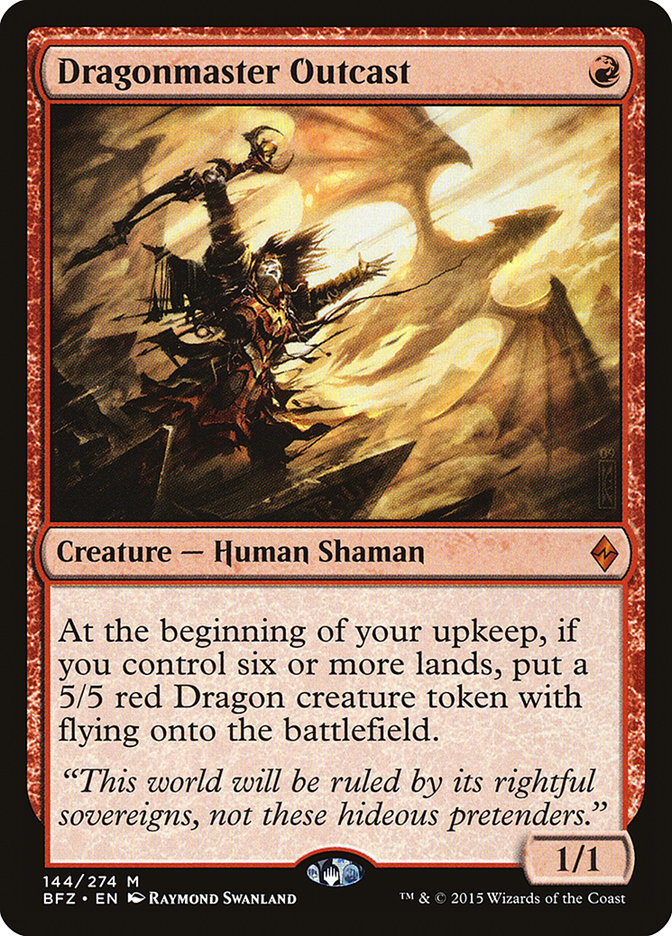There you have it. The first week of Aether Revolt Standard has come and gone and B/G Delirium is back on top. But, as many of you already know, this version of B/G Delirium doesn’t look all that much like its predecessor. Instead of playing a ton of cards to increase consistency (think Grapple with the Past, Vessel of Nascency) and revolving around casting Ishkanah, Grafwidow until the opponent’s eyes start bleeding, we’re left with something of a hybrid with B/G Aggro. In fact, three of the Top 4 decks all featured roughly the same shell:
As for the removal spells, all three versions opted for some number of Fatal Push and Grasp of Darkness, with two players leaning toward four copies of the latter. So, with all of these similarities, what made Brennan DeCandio’s version the best of the bunch? There are a lot of moving pieces here, so try to stay with me.
Oh, well, I guess there was just the one moving piece. A giant flier for four mana that enables delirium seems a lot better now that Reflector Mage is out of the picture, huh? Not only does this card hit hard, but flying and trample mean you’re going to win most races as long as you’re either killing their creatures or gumming up the battlefield. Verdurous Gearhulk and Rishkar, Peema Renegade do a great job of piling on the counters so that your creatures will be big enough to kill opposing planeswalkers or walk through combat.
While Mindwrack Demon doesn’t have a huge impact on the battlefield when it enters, there is a lot to be said about how solid it was even with Reflector Mage running rampant. Many versions of B/G Delirium started to play two, three, and sometimes four copies of this card because it was efficient, had flying, and gave you an easy way to pressure planeswalkers. Now that Reflector Mage is gone, I don’t see that changing anytime soon.
Creatures (25)
- 4 Mindwrack Demon
- 2 Tireless Tracker
- 4 Grim Flayer
- 4 Verdurous Gearhulk
- 4 Winding Constrictor
- 3 Rishkar, Peema Renegade
- 4 Walking Ballista
Lands (23)
Spells (12)

This deck has so many efficient “must-kill” creatures that many late-game threats like Mindwrack Demon or Verdurous Gearhulk will eventually close it out. Personally, I’m not a huge fan of decks like this. I was duped into playing B/G Aggro at the Players’ Championship by Brad Nelson, and the only part I really enjoyed was looting with Smuggler’s Copter. Now that Smuggler’s Copter is gone, I didn’t think anything could bring me back to the deck, but I was wrong.
Here we have a new two-drop creature that will dominate most games. Whether that means making a big Walking Balista or putting an absurd amount of power onto the battlefield with Rishkar, Peema Renegade is irrelevant. So many small interactions with Winding Constrictor lead to incredibly lopsided games. At this point, I just need to figure out a way to beat the mirror, as this deck is easily the front-runner for “deck to beat” at #PTAER.
One really cool thing about winning the first Open when a new set comes out is that you can bet your bottom dollar that every professional Magic player in the world is going to play with your deck. Testing out the deck that won the first major tournament is, without a doubt, the highest priority. First of all, they need to set the groundwork for the rest of their testing process. That means proxying up all the strategies that had success in the early weeks. And when your deck wins the tournament, they try everything in their power to make sure whatever strategy they do end up playing is rock-solid against it.
Why? Because many of the players going into the Pro Tour don’t have two weeks to take off work or school and test for the tournament. They’re going to pick up your deck, too, and if they like it, then they’ll probably play it. We saw this with Bant Company and even W/R Vehicles over the course of the last three Pro Tours. While neither of these decks won the tournament, they had solid showings and put pilots into the Top 8. Even after all that testing, trying over and over again to beat the strategy, it was good enough to survive being a known quantity.
And that’s the really impressive part. A deck that can survive through a field of 3-500 professional players while being Public Enemy Number One is kind of ridiculous. But people will say “Collected Company, Reflector Mage, and Smuggler’s Copter were too powerful, one even got banned!” And those people might be right, but we’re still living in a world where rares and mythics are dominating Standard. And, if that is the case, doesn’t that mean that B/G Aggro in one form or another is going to be a major player at #PTAER?
But what kind of cards are actually good against B/G Aggro? And, if we’re going even deeper after that, what cards will be good against those (think Level 1 and Level 2)? Today we’re going to try and figure out what cards in Standard can help dismantle B/G Aggro, as well as what you can expect from the “next level” when the Pros figure out that information.
The Pro Tour and Leveling Up
Thanks to the results of #SCGCOL, we have officially found Level 0 when it comes to testing for the next few weeks. We’ve already talked a bit about B/G Aggro, but one other card combination made a huge impact on the tournament. If you were paying any attention at all over the last few weeks, you should have seen this coming.
Honestly, I thought the decks featuring the combo were pretty interesting. We saw three-color versions act a whole lot like a normal control deck with a backdoor combo element. I probably saw more games won by Torrential Gearhulk and planeswalkers than the combo itself. And honestly, I don’t know if that’s a good thing. When we expect to play against a certain combo, it is always challenging when that deck can operate on another level. And since the Saheeli Rai combo is so easy to splash, much like Splinter Twin, the deck can be built to reliably close games via other means.
The other version(s) of the deck were a bit different from what I was expecting to do well, but overall not an unknown quantity. I expected Cloudblazer and other permanents that paired nicely with both Saheeli Rai and Felidar Guardian. But what I didn’t expect was Oath of Chandra. That card, when paired with Felidar Guardian, actually gave me goosebumps. I’m not sure why, but having a way to turn half of your combo into Flametongue Kavu really pulled at my heartstrings.
But adding the two breakout decks from #SCGCOL to the list, there seem to be some pinpoint locations in the format we can exploit. And for us to do that, it may require looking back over all the cards in Standard to figure out just what can be used to accomplish this goal. If B/G Aggro continues to grow in popularity (which I think it will), then the threat of planeswalkers begins to diminish. That means we can afford to take some turns off killing creatures in an effort to gain card advantage, battlefield advantage, or both. If we can play enough interaction for the Saheeli Rai combo decks as well as the B/G Aggro decks, I think we’ll be in good shape.
For Pro Tour Aether Revolt, I think there will be a short list of cards that could help a few archetypes make a strong comeback. Let’s get started with my Top 5.
Haunted Dead was making quite the impression in the early rounds of Kaladesh Standard, and I’m not exactly sure what changed. Prized Amalgam and Haunted Dead go together like peanut butter and jelly, and both are fantastic against a format full of removal spells. The downside here is that it might be tough to build a Haunted Dead deck without Smuggler’s Copter, and it could be difficult to find enough ways to interact with the Saheeli Rai combo, but I think that Haunted Dead definitely needs a second look.
For me, playing against Haunted Dead in the early stages of Kaladesh Standard was a nightmare. I just wasn’t prepared to deal with creatures that could consistently come back to life, and most of the decks I built weren’t able to close games before that recurring card advantage was able to do me in. Perhaps it was Aetheworks Marvel that killed the beast, but with Her Majesty Queen Emrakul, the Promised End leaving the format, Aetherworks Marvel is looking less and less appealing. Combo variants of Aetherworks Marvel have fewer big cards to hit, and control variations don’t have a finisher that is reasonably castable.
If everyone in the format is moving more toward fairly slanted strategies, Haunted Dead and the staggering crew could be poised for a major comeback.
Why, yes, I do think Lightning Axe is well-suited for the current job of “killing every creature in Standard.” Well, obviously not every creature, but you get the point. U/R decks in general have a tough time killing creatures with a high toughness. With Winding Constrictor making such big waves at the moment, it might be tough to overcome a start from the opponent featuring Winding Constrictor into Rishkar, Peema Renegade. Lightning Axe and Fiery Temper can help with that.
But Lightning Axe by itself won’t turn games around. First, you need a good reason to play Lightning Axe. Many U/R strategies focus around pure card advantage and try to play the control role. I don’t really want to do that right now. Counterspells seem fairly weak at the moment, since they get worse and worse as you fall behind. On top of that, Revolutionary Rebuff isn’t all that great if your opponent has the luxury to play around it because you aren’t putting pressure on them.
But what does Lightning Axe actually do for a U/R deck? Well, I never thought you’d ask.
Creatures (7)
Lands (23)
Spells (30)
- 3 Shock
- 4 Fiery Temper
- 3 Lightning Axe
- 2 Tormenting Voice
- 4 Take Inventory
- 1 Incendiary Flow
- 4 Harnessed Lightning
- 4 Dynavolt Tower
- 4 Cathartic Reunion
- 1 Glimmer of Genius
Sideboard

While a bit vulnerable to the likes of Negate or Spell Queller, this deck thrives on formats full of small creatures. I have been trying out new cards like Baral, Chief of Compliance, but I found that to be underwhelming. Making your spells cheaper can be very good, and looting on counterspells is also fine, but I found it rare that any deck I was building wanted (or needed) to do both at the cost of two mana and a card.
There are likely better ways to build this deck, but I wanted to emphasize killing creatures over anything else. A few copies of Negate in the maindeck couldn’t hurt, but I just wanted to make sure I wasn’t getting stuck with creatures in my hand. After sideboarding, we have a bit of help against opposing decks with annoying non-creature permanents. Negate and Spell Shrivel go a long way in protect you from those types of spells when you’re able to cheaply handle early creature-based starts.
I don’t know why we forgot about this one. Elder Deep-Fiend seems pretty good in a format revolving around racing and a lot of sorcery-speed heavy hitters. It doesn’t die to Fatal Push, Grasp of Darkness, or most reasonable Harnessed Lightnings, and it can enable the Flashback on Kozilek’s Return (which seems decent in a world full of B/G Aggro). While I don’t know if the traditional Temur Emerge shell is viable anymore, there are quite a few graveyard elements that make me want to take a second look at Elder Deep-Fiend.
Creatures (19)
Lands (23)
Spells (18)

This is a good starting point, and one of the cooler decks to come out of Pro Tour Kaladesh. I was excited to see it on camera, and ended up playing against it quite a few times on Magic Online in the following weeks. For some reason, it fell out of favor, and I’m not exactly sure why. Honestly, if I have to compare this to the Haunted Dead decks, I’d lead toward this one. It doesn’t care much about counterspells, or removal that doesn’t exile.
Kozilek’s Return can help you stabilize against most variations of G/W Tokens, B/G Aggro, and Mardu Vehicles. In general, I think that Elder Deep-Fiend and Kozilek’s Return should go hand in hand. It is one of the most powerful combinations in the format, allowing you to sweep your opponent’s battlefield and tap down all their lands in their upkeep. Assembling this combination can be tough at times, but this deck is designed to do it more fluidly than any other strategy.
This version above doesn’t showcase any new cards, and honestly, I don’t even know if any new cards deserve consideration. I just think that Elder Deep-Fiend is criminally underplayed and this style of deck could help hammer that point home.
With Gonti’s Aether Heart being the premier big artifact to look out for, I wouldn’t be surprised if there were more than one Refurbish deck to come out of the Pro Tour. I thought it was a very powerful card alongside Combustible Gearhulk when Kaladesh was released, and it should only get better over time.
Aside from Gonti’s Aether Heart, Paradox Engine seems particularly disgusting in the right shell. The fact that you can also use Refurbish after casting Baral’s Expertise makes me absolutely giddy. While returning an artifact from your graveyard to the battlefield will only be as good as the artifacts you can bring back, the Kaladesh block has offered up a few that I find particularly juicy.
While not a lot of people are talking about Refurbish, I think it might be one of the biggest sleeper cards in the block. I liked it a whole lot right when Kaladesh came out, but there seemed to be something missing in the deck. If the only thing we’re bringing back with Refurbish is Combustible Gearhulk, I’d be surprised. I could even see it making waves in a Metalwork Colossus deck, assuming it had the Cathartic Reunion / Tormenting Voice or some other discard package to go along with it. We have a lot of enablers in Standard for Refurbish, which leads me to believe that there’s something there that we just haven’t found yet.
In a control mirror, having your win condition be cheap means you can easily protect it with counterspells. On top of that, if that card is a creature, it has a higher chance to survive after sideboarding, since both players are likely cutting down significantly on their removal spells. Dragonmaster Outcast is the answer that I was looking for when building all these U/R Control decks over the last few weeks, but don’t get too far ahead of me.
Dragonmaster Outcast is a sideboard card. A powerful sideboard card, for sure, but one that will shine in a control mirror. I’ve played a good bit with Dragonmaster Outcast in the past, when I had access to Kolaghan’s Command and Ojutai’s Command, but now we don’t have the luxury of such seamless recursion. Instead, we’re focusing on getting to a point in the later turns of the game where we can cast Dragonmaster Outcast on a mostly clear battlefield, using all of our remaining mana and cards to protect it…at all costs. If this card survives until your next turn and you’re trading resources one-for-one, it will be very tough to beat.
Now, that isn’t to say that it will be the best possible thing you can do in any given control mirror. Some players might decide to keep in the bulk of their removal spells simply because Dragonmaster Outcast exists, but I wouldn’t bet on it. Here, the worst-case scenario is that it gets countered or killed, both of which more than likely allowed you to trade up on mana, which could give you a better spot to resolve something like Torrential Gearhulk or Glimmer of Genius. As always in a control mirror, just play your cards with tight sequencing and try to protect whatever spell(s) feel most important at the time.
Creatures (4)
Planeswalkers (1)
Lands (26)
Spells (29)

…
With #SCGRICH and #PTAER on the horizon, Standard is on everyone’s mind, myself included. My gut is telling me that B/G Aggro is the deck to play this weekend. I don’t have any delusions that I’m good enough to build a control deck that can consistently beat this deck. It has explosive starts that can easily overwhelm the opponent, and it has already shown consistency in execution. I’d be a fool to play something different. At this juncture, my main worry is the mirror match, which I’m sure to face multiple times (any suggestions welcome).
Wish me luck.



